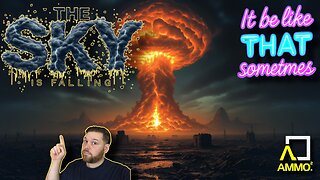Premium Only Content

How Big is The Universe
The universe is **mind-bogglingly vast**, and its size is one of the most fascinating and humbling aspects of existence. Here's a breakdown:
---
### **Observable Universe**
The observable universe refers to the portion of the universe we can see and measure, limited by the speed of light and the age of the universe (~13.8 billion years). Here's what we know:
- **Diameter:** ~93 billion light-years.
- **1 light-year** = ~9.46 trillion kilometers (5.88 trillion miles), so the observable universe spans **880,000,000,000,000,000,000,000 kilometers**.
- This includes all the galaxies, stars, planets, and cosmic structures we can observe with telescopes.
---
### **Beyond the Observable Universe**
- The actual universe is likely much larger (possibly **infinite**), but we cannot observe it due to the **cosmic light horizon** — the farthest distance light has traveled since the Big Bang.
- Current theories suggest the universe may be:
- **Finite but unbounded** (like the surface of a sphere in 3D space).
- **Infinite**, extending forever in all directions.
---
### **Scale Comparison**
To understand its scale:
1. **Earth to Sun:** 1 Astronomical Unit (~150 million km). Tiny compared to the universe.
2. **Milky Way Galaxy:** ~105,000 light-years in diameter.
3. **Local Group of Galaxies:** Spans about 10 million light-years.
4. **Observable Universe:** Contains at least **2 trillion galaxies** and about **10^24 stars** (that's a **1 followed by 24 zeros!**).
---
### **What's Beyond?**
We can't directly observe beyond the edge of the observable universe, but theories suggest:
- There could be **other universes** (multiverse theory).
- The universe might loop back on itself in some higher-dimensional shape.
In short, the universe is not just big—it's **unfathomably colossal**! Would you like a visual or simulation-based analogy to help grasp these immense numbers?
-
 15:48
15:48
Sponsored By Jesus Podcast
18 hours agoHow to Stop Being JEALOUS | When Comparison Steals Your Joy
12.9K11 -
 3:56:59
3:56:59
DLDAfterDark
9 hours ago $12.74 earnedDon't Worry - Things Will Get SO Much Worse! Sometimes It Be Like That
27.1K6 -
 25:41
25:41
Robbi On The Record
14 hours ago $3.81 earnedThe Billion-Dollar Lie Behind OnlyFans “Empowerment” (Her Testimony Will Shock You) | part II
16.9K12 -
 12:22
12:22
Cash Jordan
6 hours ago"CHICAGO MOB" Fights Back... "ZERO MERCY" Marines DEFY Judge, SMASH ILLEGALS
33.9K46 -
 46:58
46:58
Brad Owen Poker
18 hours agoI Make QUAD ACES!!! BIGGEST Bounty Of My Life! Turning $0 Into $10,000+! Must See! Poker Vlog Ep 323
19.9K7 -
 2:52:28
2:52:28
TimcastIRL
9 hours agoSTATE OF EMERGENCY Declared Over Food Stamp CRISIS, Judge Says Trump MUST FUND SNAP | Timcast IRL
252K146 -
 3:22:45
3:22:45
Tundra Tactical
16 hours ago $21.16 earned🚨Gun News and Game Night🚨 ATF Form 1 Changes, BRN-180 Gen 3 Issues??, and Battlefield 6 Tonight!
46.6K6 -
 1:45:13
1:45:13
Glenn Greenwald
12 hours agoJD Vance Confronted at Turning Point about Israel and Massie; Stephen Miller’s Wife Screams “Racist” and Threatens Cenk Uygur with Deportation; Rio's Police Massacre: 120 Dead | SYSTEM UPDATE #540
122K169 -
 9:05:24
9:05:24
SpartakusLIVE
10 hours agoSpart Flintstone brings PREHISTORIC DOMINION to REDSEC
41.2K10 -
 1:05:02
1:05:02
BonginoReport
13 hours agoKamala CALLED OUT for “World Class” Deflection - Nightly Scroll w/ Hayley Caronia (Ep.167)
137K85